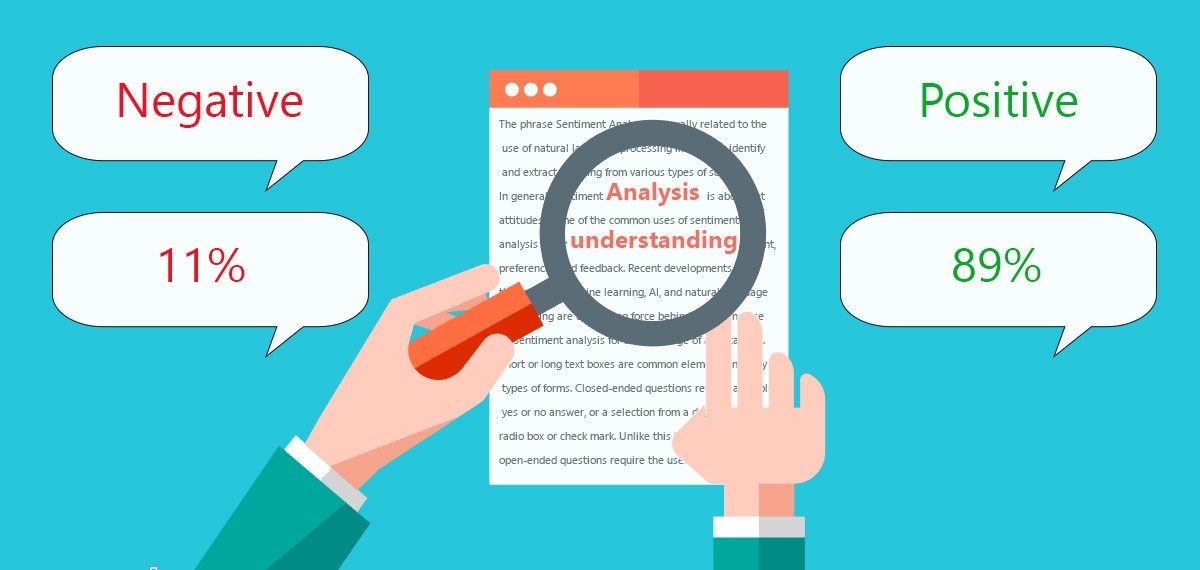Category:Scraping Use Cases
Sentiment Analysis with Web Scraping, How Is It Work? | Scrape.do

Full Stack Developer
A slight change in someone's tone, a sarcastic yet poignant comment, and more is an indication of how complex and expressive human emotions can be. Language and emotions can reveal our deepest fears and desires, as well as lead us to misrepresent ourselves.
We all know how important emotions and the way we express them are for human psychology. But what happens when our emotions enter the economy, how do our emotions affect companies? In fact, this is a question that companies that want to develop are also curious about. However, they use sentiment analysis to explore our emotions and offer services and products that meet our wishes.
As the Scrape.do team, in this article, we told you what sentiment analysis is, the types of sentiment analysis, how sentiment analysis works, and the places where sentiment analysis can be used. The first thing you need to do in order to be able to do sentiment analysis and improve your business by understanding the sentiment analysis of your customers is to read this article and the second thing is to contact us! Moreover, we help you with anything that comes to your mind.
What Does Sentiment Analysis Mean?
Sentiment analysis, in which many techniques such as natural language processing and computational linguistics are used, is a type of analysis that companies perform in order to understand the feelings and wishes of customers as a result of the collection and classification of texts on the internet. With this analysis method, it is easier to determine which brands or products consumers react to and how they react compared to natural ways.
In this analysis method, human expressions are classified in three main ways and these shapes are positive, negative, and neutral. You can easily see this method on Google or Amazon, which a customer uses to understand whether a customer's reaction to any product is positive or negative. The stars you see when buying a product on Amazon and looking at a restaurant on Google are an example of sentiment analysis.
What are the Types of Sentiment Analysis?
We mentioned that sentiment analysis focuses on the polarity of a product or service evaluation, these poles are positive, negative, and neutral. However, some sentiment analysis types can also have attributes such as angry, happy, sad, or urgent, not urgent.
The type of sentiment analysis that a store should choose varies depending on how the customer wants to evaluate their feedback and queries. In this section, we touched on the most popular types of sentiment analysis, namely graded sentiment analysis, sentiment detection, aspect sentiment analysis, and multilingual sentiment analysis.
Graded Sentiment Analysis
In the graded sentiment analysis method, which is ideal for businesses that want to evaluate more clearly and precisely, two extremes are determined and one of these extremes expresses the most negative while the other expresses the most positive. As an example, we can show a ranking in which 5 is very positive and 1 is very negative. You can also edit this rating as a star.
Very positive - 5
Positive - 4
Natural - 3
Negative - 2
Very negative - 1
Sentiment Perception
Sentiment perception analysis does not clearly have polarities compared to graded sentiment analysis, so it is not possible for a consumer to make very positive or very negative comments directly to you. Instead, this method involves emotions such as happiness, disappointment, anger, and sadness. Because customer feedback in this method can be quite difficult to understand, predetermined and integrated dictionaries or complex machine learning algorithms are often used.
There is a serious disadvantage in the sentiment perception analysis method. In this method, when a dictionary is used, people's feelings are accepted within certain patterns. Some people may express their feelings aggressively. For example, when a person writes the comment "I wanted this dress badly since summer", the sentence may be perceived as negative because of the word "badly" in this sentence, but the evaluation is extremely positive.

Aspect Based Sentiment Analysis
The aspect-based sentiment analysis method is used additionally for specific situations, you cannot use this method alone like graded sentiment analysis. The most important reason for this is that this method is for you to understand which aspects of a product people are satisfied with and which aspects are negative. So, if you're selling a shoe, you might want to know if customers find the shoe size large or small, that's what this method is for. In addition, we can say that there are two opposite poles in this method, such as very positive and very negative. For example, short-long, wide-narrow, and small-large.
Multilingual Sentiment Analysis
The multilingual sentiment analysis method is the most difficult method among sentiment analysis methods. This method is not generally preferred by amateurs as it involves a lot of preprocessing and adding resources. In order to perform multilingual sentiment analysis, resources, some of which are available online and some that need to be created from scratch, must be added to the algorithm. In order to perform these algorithm operations, you must have at least an average level of coding and programming knowledge.
How Do Sentiment Analysis Algorithms Work?
In the sentiment analysis method, which can also be called opinion mining, natural language processing, and machine learning algorithms are used to automatically analyze online reviews and comments. Which algorithm you should use depends on how much data you need to analyze and how accurate you want your model to be. Before we go into these algorithms in detail, we have prepared a table for you to review:
Sentiment Analysis Algorithm
Brief Description
Rule-based Sentiment Analysis Algorithms
In these algorithms, a set of manually created rules are used to automatically perform the sentiment analysis desired.
Automated Sentiment Analysis Algorithms
Data learning technique is used to perform sentiment analysis and mainly rely on machine learning techniques.
Hybrid Sentiment Analysis Algorithms
Both the rule-based approach and the automated approach are utilized.
1. Rule-based Sentiment Analysis Algorithms
In sentiment analysis algorithms that work on a rule-based basis, a set of rules made by people can be added to the algorithm to help determine whether an evaluation is positive or negative. These rules added to the algorithm can be from various NLP techniques, examples of these techniques are stemming, tokenization, speech fragment tagging and parsing, and dictionaries.
In rule-based sentiment analysis algorithms, it doesn't matter in which order the words are combined, only whether the word is used and whether it is positive or negative. Since the rules in these algorithms are set by human hands, of course, more advanced techniques can be used and new rules can be included in the algorithm, but each time a new rule is added, the previous rules may be affected and the system may become complex from the beginning. Also, rule-based sentiment analysis algorithms need constant fine-tuning and maintenance, so these algorithms cannot be one-off and require regular payments.
Here is an example of how the rule-based sentiment analysis algorithm works:
- As a first step, you define a list of words. This list of words should consist of dictionaries that will be evaluated as bad, such as bad, worst, ugly, awful, and disgusting, and words that will be evaluated as good, such as great, very good, best, good, and excellent.
- If the number of positive words in a comment is more than negative words, the system perceives this comment as positive and forwards it to you. However, if there are too many negative words, the comment is considered negative. If positive words and negative words are equal, they are considered neutral.
2. Automatic Sentiment Analysis Algorithms
In automatic sentiment analysis algorithms, unlike rule-based sentiment analysis algorithms, you do not need to add any rules. All operations in these algorithms are based on machine learning. The analysis task of this algorithm is set as a classification problem, then a classifier text is added and this classifier text is evaluated as positive, negative, and neutral.
- Training Process: The algorithm has thoroughly learned the test examples that have been used before in the training process and tries to learn to associate the information it has learned with the text entered into it with the label. This algorithm, which is described as a feature extractor, transfers the text to the feature vector, allowing the text to be evaluated as positive, negative, or neutral.
- Prediction Process: In this process, the feature extractor transforms the text into feature vectors and feeds these feature vectors into the model that generates the predicted labels.
- Classification Algorithms: Naive Bayes, Linear Regression, Support Vector Machines, or Deep Learning are generally used as classification algorithms.
Naive Bayes
Bayes Theorem is used for the category of the text used as input.
Linear Regression
Used to predict some values whose properties are determined by a set, this algorithm is very often used in statistics.
Support Vector Machines
Treats text instances as representative points in a multidimensional space and is not a probabilistic model.
Deep Learning
Artificial neural networks are used to process data, in this method a series of algorithms is used and this series tries to learn something by imitating the human brain.
3. Hybrid Sentiment Analysis Algorithms
In hybrid sentiment analysis algorithms, the desired features of rule-based and automatic sentiment analysis algorithms are combined and used as a single algorithm. The most important reason for using these systems is that the results are more accurate than other algorithms.
The Most Common Uses of Sentiment Analysis
Sentiment analysis can be used for different purposes in many areas. We can list the most frequently used areas where sentiment analysis can be used as follows:
- Brand Monitoring: If a customer is leaving a review and it's a negative review, the customer is doing it to get their voice heard, and sentiment analysis works just fine. If companies have launched a new product or launched a new campaign, they can improve themselves by examining the comments of their customers.
- Monitoring Employee Feedback: Employee feedback may seem meaningless to a company executive, but employee feedback can help a company grow or shrink. With sentiment analysis, organizations can analyze employee emotions and better interpret these analyzes by segmenting them. In addition, when regulations are made taking into account the opinions of the employees, the efficiency of the employees will increase, and this will benefit the company.
- Product Analysis: By performing sentiment analysis, it is easier for organizations to understand which products are sold out quickly, and which products can be improved by taking into account the negative comments made by customers about a specific product. In addition, more sales can be achieved by emphasizing the good aspects of the products.
- Improving Customer Support: According to a recent study, more than a quarter of customers stop using that company's products completely after a single bad customer support experience. Considering that customer support is of such great importance, organizations need to improve their customer service team with sentiment analysis. It will be sufficient to examine social media platforms, blogs, and forums to detect this. If there is a negative opinion, many users will have already given advice.
By using our scraper service that we have offered to you as Scrape.do, you can maintain your sales competitively, examine how your products are reflected on social media, improve your customer support, make product analysis, and provide crisis management and monitor your brand. All you need to do to achieve all this is to perform a sentiment analysis with the help of a good and powerful scraper. For this, simply fill out the contact form on our website and contact us! Remember, we always want the best for you.
{{< link "https://scrape.do/blog/how-can-web-scraping-help-political-campaigns/" "Web Scraping and Political Campaigns" >}}

Full Stack Developer












